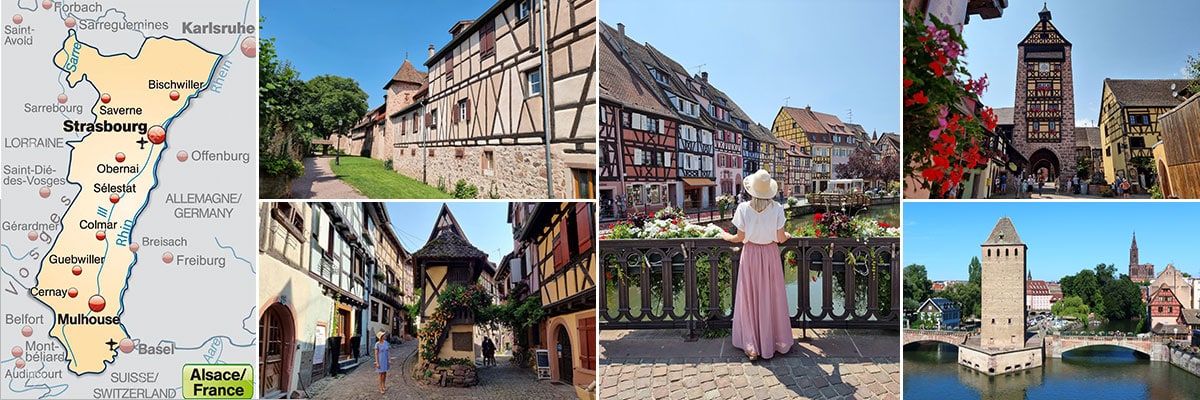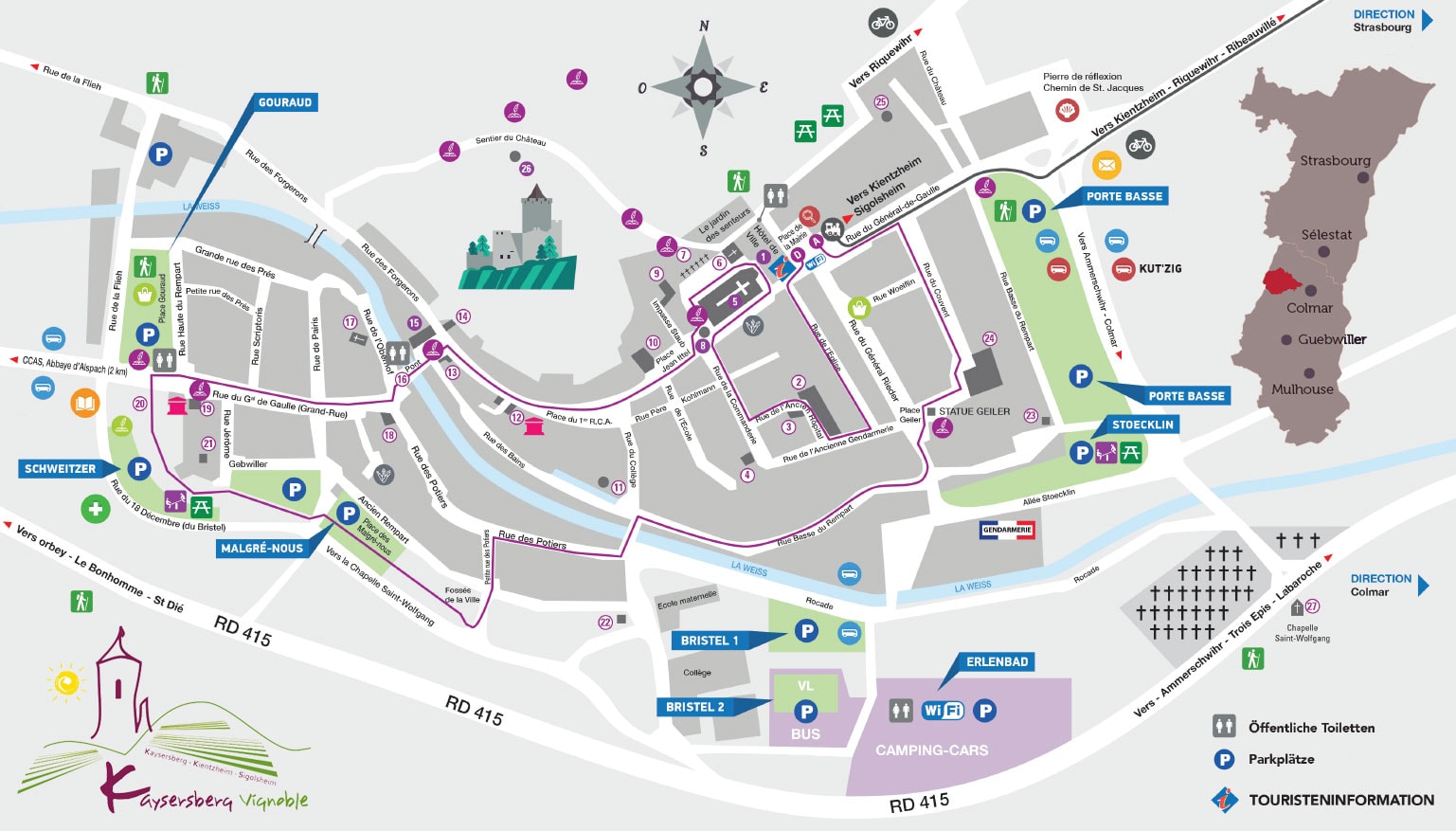Kaysersberg is located about ten kilometers northwest of Colmar and is one of the most visited towns in Alsace. The idyllic half-timbered town on the Alsace Wine Route enchants with its beautiful medieval old town with remains of the old town fortifications, numerous ornate half-timbered houses and the ruins of Kaysersberg Castle. We visited Kaysersberg as a day trip from Colmar and saw the main sights of the town in just over two hours on foot.

Table of contents
Things to know about Kaysersberg in Alsace
The picturesque half-timbered village of Kaysersberg is a French municipality with about 2,500 inhabitants and is idyllically located in the valley of the Weiss River on the Alsace Wine Route, about ten kilometers northwest of Colmar. The valley of the Weiss was used in the Middle Ages as an important communication route between the Rhine plain and Lorraine. The settlement “Castrum Keisersberg” located there was first mentioned in a document in 1227, when the Holy Roman Emperor ordered the purchase of a small castle to control the valley of the Weiss. The Emperor decided to build here one of the largest fortresses of his defense line to protect himself from the Dukes of Lorraine, who could have used this easy way to invade the Empire.
On March 18, 1293, Kaysersberg, like the neighboring town of Colmar, was elevated to the status of an imperial town and developed on the basis of crafts and, in particular, trade in Alsatian wine. The Staufenburg, which was built in the Middle Ages, is still preserved as a mighty castle ruin. Today, Kaysersberg is best known for its beautiful old town with its cobblestone alleys, numerous half-timbered houses, the church of Sainte-Croix, parts of the old city fortifications, and its tasty fruit brandies, which you should try during a visit. In addition, Kaysersberg is the birthplace of Nobel Prize winner Albert Schweitzer.
Sights in the old town of Kaysersberg
We traveled to Kaysersberg in our own car and parked it in one of the many metered parking lots on the outskirts of town. From here it is only a stone’s throw to the old town. We were here on a weekday morning, so the city streets weren’t quite as busy – which was great for taking a relaxed, stress-free look at everything.
Towers & old city wall
The urban area of Kaysersberg has developed over time in three stages. The original village was delimited in the north by the ramparts of the Staufenburg and in the south the course of the Weiss River was the natural boundary of the town. In the following centuries, the city was first extended over the watercourse of the Weiss to the southwest (quarters Rue des Potiers, street Oberhof and Rue de Pairis) and later towards the east. As the city expanded over time, so did the fortifications. Today, unfortunately, very little of it can be seen. Only 5 city wall towers have been preserved:
Kessler Tower: Built in 1372, the city wall tower, also called Kessler Tower, is the highest of the city’s defense towers, with a height of 22 meters. The original door to the tower is high up and was only accessible by a ladder that could be pulled out to protect the tower from attackers.
Witches Tower: The 20 meter high Witches Tower, also called Junker Hansen Tower, is located on the side of the vineyard in Kaysersberg. As with other towers in the city, thieves and other criminals were imprisoned here at that time. The tower was built in the 14th century and is adjacent to the former residence of the Reichenstein family, which now houses the family-run 5-star Relais et Châteaux Le Chambard hotel and restaurant.
High Gate Tower: The 12-meter high tower of the Porte Haute, also called the Upper Gate Tower, once served as a watchtower to defend the city. The tower dates back to the 15th century and has kept its embrasures until today.
Hospital Tower: The Hospital Tower, also called Burger Tower, was built in the 15th century and is located directly behind the old hospital, which also gave it its name. It served as a powder magazine at that time.
Pfaffenturm: Of this former tower, only the lowest part with the embrasures remains today.
Fortified Bridge & Upper Court Chapel
Our first port of call in the center of Kaysersberg was the area around the Fortified Bridge, which runs along the 24-kilometer-long Weiss River. After the erection of a first simple wooden structure, a fortified stone bridge was built here in 1514 to prevent enemy incursion across the river. For this purpose, the bridge was equipped with embrasures and parapets on both sides, which were pierced with archers and gunners. A distinctive feature is that in the middle of the bridge there is a small chapel. Before a polychrome statue of the Virgin and Child found its place in the chapel, residents who had committed minor offenses were imprisoned here, making them the laughing stock of the town.
One of the most beautiful photo motifs in Kaysersberg for us is the view from the right bank across the river. Looking across the river, you can admire the Upper Court Chapel, also called “Notre-Dame du Scapulaire”, built in 1391. It is one of the structures that survived the vandalism of the Revolution and has been classified as a historical monument since 1946. Right next to it is a beautiful half-timbered house with green shutters, lushly flanked windowsills and a peaked roof. A real postcard motif!
On the bridge there is also the building Hostellerie du Pont, built at the beginning of the 17th century. It served as accommodation and office for the municipal gourmet official who accompanied tourists on their wine tastings. Today there is a banquet hall on the second floor and public toilets in the basement.
A tour of the old town
You can stroll through the cobbled streets of the old town on foot, because they are traffic-calmed. There are many beautiful old buildings decorated with flowers and richly decorated half-timbered houses here. One photo motif definitely chases the next here. Small squares, cute cafes and restaurants invite you to linger here on almost every corner. When the weather is nice, you can sit wonderfully outside in the localities and enjoy the hustle and bustle.
A few meters from the Fortified Bridge, the Faller Brief House (Maison Brief-Faller) is considered one of the most beautiful and imposing houses in Kaysersberg. The picturesque corner house was built in 1594 in the style of Rhenish Renaissance architecture, has a nearly square main body and a deep off-center porch, several stories of timber framing, carved and turned posts, and a first floor of pink Vosges sandstone. Today the house houses a restaurant as well as a wine cellar where you can taste and buy Alsatian wines.
We first walked along Rue du Général de Gaulle until we arrived at the Church of the Holy Cross (Sainte-Croix Church). The church was built between 1230 and the 16th century and is dedicated to the Holy Cross, of which it is said to have possessed a relic. Particularly striking in the church is the oversized figure of Christ and a carved altar from 1518. In front of the church is the beautiful fountain of the Emperor Constantine.
Behind the Church of the Holy Cross stands the imposing town hall building (Hôtel de ville), built in 1604 in the Rhenish Renaissance style from Vosges sandstone. In addition to its function as an administrative center, it was once used as a residence for the imperial bailiff, the emperor’s direct representative on the territory of Kaysersberg. Today you can find here the offices of the Kaysersberg town hall and the tourist office.
The castle of Kaysersberg
The castle of the same name towers above Kayserberg and is easily recognizable from afar. The imperial castle was created in the Middle Ages (around 1200) – primarily with the purpose of a passive and active military defense function. The town of Kaysersberg was of great strategic importance at that time, as it allowed the Weiss Valley to be sealed off along the Vosges Road – the link between Upper Alsace and the Duchy of Lorraine.
Of course, we didn’t want to miss the chance to climb the castle and enjoy the view of the city and the surrounding area from above. Three different paths lead to the castle, with the ascent taking between 15 to 20 minutes. Two of the paths (marked yellow & blue) also lead over steps, among other things; the third path (marked red) is at ground level and thus also well suited for families with children. Behind the town hall two of the paths start and so we could directly start our little hike. A short time later we arrived at the mighty castle ruins, which are located at an altitude of 295 meters.
On the castle grounds, the huge cylindrical keep with its 4.42 meter thick walls and 11 meter diameter is particularly striking. The climb to the top of the keep is very rewarding. After about 100 steps here we could enjoy a breathtaking panorama over Kaysersberg and the surrounding vineyards.
We spent a wonderful morning in this picturesque town and can highly recommend a day trip from Colmar. Ideally, you come here on a weekday so it’s a little quieter and more relaxed.
The most beautiful Alsace Villages (France)
Half-timbered towns, wine villages, castles, medieval city walls and tarte flambée... we spent a few days in Alsace, France. Here you can find our travelogues of some of the most beautiful towns in the region. » Strasbourg - Tourist Attractions, Things to Do & Photo spots
» Strasbourg - Tourist Attractions, Things to Do & Photo spots» Colmar - Top 15 sights in the old town
» Kaysersberg – Sights, Old Town & Castle
» Riquewihr - One of the most beautiful villages in France
» Eguisheim - Top sights of the medieval town
» Turckheim - A day trip from Colmar
» Ribeauvillé – Top Sights & Photo Spots
» Neuf-Brisach - own and Fortress (UNESCO World Heritage)

